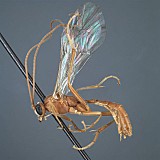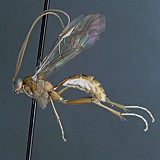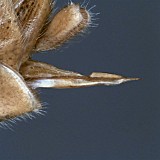Frons without median horn or elevated carina. Clypeus short and wide, flat or more commonly with rounded transverse ridge or median elevation; ventral margin sharp throughout, often impressed medially and occasionally difficult to see medially because of partially overlapping median elevation; ventral margin varying from truncate to deeply and narrowly emarginate medially, with lateral margins rounded or more distinctly angled dorsally; epistomal sulcus varying from shallow to narrow and more distinct. Malar space usually shorter than half basal width of mandible. Mandible (Fig. 1) moderately long, narrow throughout, curved, ventral tooth varying from slightly longer than, equal to, or slightly shorter than dorsal tooth. Female and male ocelli often equal in size or nearly so, variable: maximum diameter of lateral ocellus shorter than distance between ocellus and eye in some species but distinctly longer than distance between ocellus and eye in others, though never as large as in
Semimesoleius. Female antenna often longer than body; first flagellomere long and slender (Figs 1, 2). Hypostomal carina joining occipital carina well above base of mandible; occipital carina complete. Dorsal end of epicnemial carina usually extending to anterior margin of mesopleuron or nearly so, rarely distinctly separated from anterior margin; mesopleuron mat. Notaulus sharply impressed on anterior declivity, often weak to indistinct on disk. Pleural carina complete, usually well-developed; median and lateral longitudinal carinae of propodeum varying from well-developed, complete or nearly so, to almost completely absent with median carinae forming a rounded petiolar area; when present, median carinae forming rounded petiolar area then strongly narrowing and extending to anterior margin, narrow areola sometimes completely delimited but sometimes confluent with basal median area; with areola not distinctly separated from basal area, costula and other lateral parts of anterior and posterior transverse carinae absent. Legs with apical comb on posterior side of hind tibia short but well developed, dense; hind tibial spurs long, slender (Fig. 1); all tarsal claws apparently simple, not pectinate. Fore wing areolet usually present; stigma about as in Fig. 2, not exceptionally broad, with Rs+2r arising from basal 0.4-0.5; 1cu-a often interstitial with Rs+M. Hind wing with first abscissa of CU1 slightly or more commonly distinctly longer than 1cu-a. T1 (Figs 1, 2) long and slender basally, gradually widening posteriorly; dorsal carinae usually absent or confined to margins of basal depression for dorsal tendon attachment, only very rarely indicated as low, rounded ridges extending to level of spiracle; dorsal-lateral carina usually sharp and distinct throughout, sometimes weaker medially around spiracle; glymma deep, broad basally, narrowing posteriorly to a shallow groove at level of spiracle. S1 extending to level of spiracle in most species, nearly so in others. T2 thyridium present; laterotergites of T2 and T3 completely separated by creases. Ovipositor short, straight, somewhat broadened basally, narrow apically, with deep, broad subapical, dorsal notch (Figs 3, 4); ovipositor sheath shorter than hind tibial spur. Apex of female metasoma as in Fig. 3.
The genus contains some very small and some fairly large, slender species.





